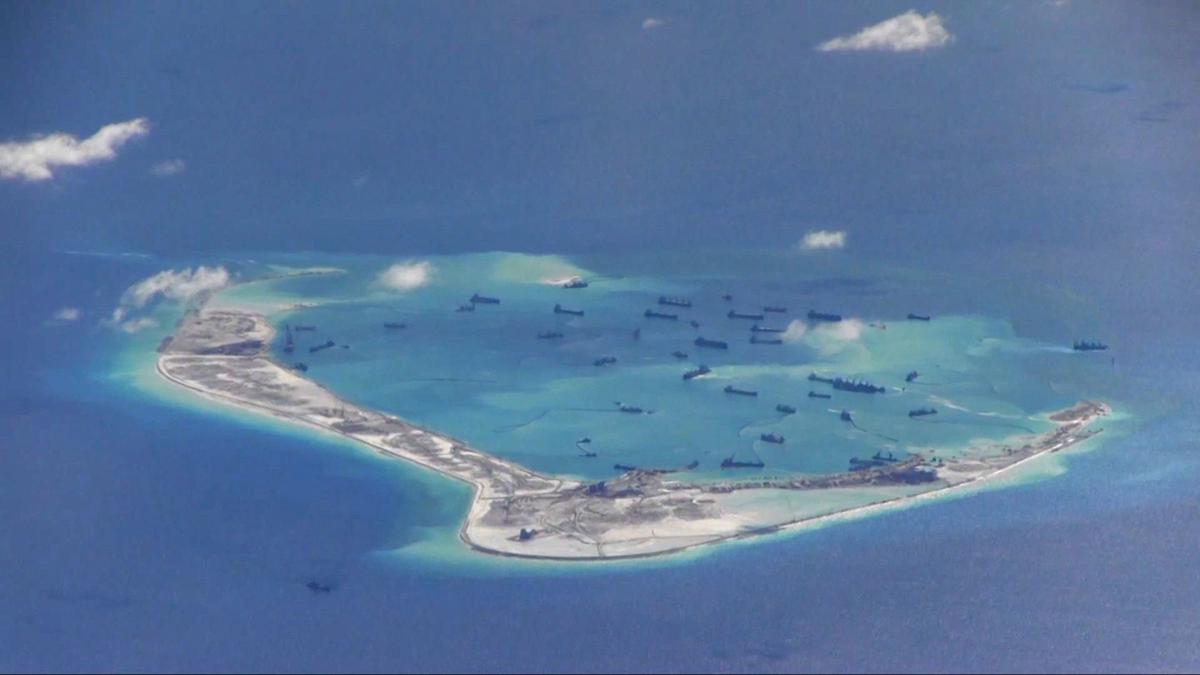Robin Beres column: Navy's return to Subic Bay sends a message to China
Chinese dredging vessels were photographed from a P-8A Poseidon aircraft around Mischief Reef in the Spratly Islands in the South China Sea, in May 2015.
As the world continues to grapple with COVID-19, and Americans remain convulsed over politics and protests, China has been on the move. The communist nation, which seems to have recovered quite remarkably from the pandemic, has been busily exerting itself globally — in ways both benign and harsh.
That President Xi Jinping hopes to transform China into the world’s premier superpower — economically, politically and militarily — has become quite clear to those still aware enough to see beyond our own borders. In the past several months, Xi has employed Chinese influence and power — hard and soft — to achieve his goals.
Of late, Beijing has adopted a far more aggressive stance toward both Taiwan and Hong Kong. Beijing has warned the U.S. about interfering in its relationship with Taiwan, darkly hinting at military might if action becomes necessary. In 2018, one Chinese official announced that the “day that a U.S. Navy vessel arrives in Kaohsiung (Taiwan’s deepwater port) is the day that our People’s Liberation Army unifies Taiwan with military force.”
In the Himalayas, Chinese forces have grown far more aggressive in the ongoing border dispute between China and India. Last month, a huge fistfight between the two militaries resulted in both armies deploying thousands of armed troops to the region that still remain in a tense standoff.
And just as worrisome is China’s use of soft power to influence and control smaller nations. China’s rapid buildup of military bases across the globe — Djibouti and the Arctic Circle are two of the more recent — has world leaders taking note.
In the South Pacific, the prime minister of the Solomon Islands recently shocked citizens with the news that the nation was cutting ties with Taiwan and switching its allegiance to China. Sources have told 60 Minutes Australia that members of parliament were paid handsomely by Beijing to switch. The move allows China to establish a presence on the very strategic islands and creates a giant headache for an uncomfortably close Australia.
Even closer to Beijing’s mainland is the South China Sea — one of the world’s most vital shipping routes for free trade. Dozens of nations and islands transport more than $5 trillion in goods across its waters every year. But China has laid claim to nearly 90% of the sea and the islands in the region. It has established military bases on atolls and reefs in the area — many of which are claimed by smaller nations such as Vietnam, Malaysia and the Philippines. In 2016, the international court at The Hague ruled that China had no rightful claim to develop the Spratly Islands chain and ruled in favor of the Philippines’ claims to the islands. Beijing has ignored the decision.
Tensions between China and the Philippines have continued to heat up as Beijing turns atolls and reefs in the region into fortified military structures. Earlier this year, China announced it had created new administrative districts for oversight of the Spratly Islands and the Paracel archipelago and claimed sovereignty over more than 80 islands and geographical features in the region.
While Philippine President Rodrigo Duterte has pivoted between befriending Washington and Beijing, most of the Philippine people and the military are far more worried about Beijing.
Given China’s power grab in the area, it’s not surprising to learn the United States Navy may be returning to its former base in the Philippines in the very near future. Naval Base Subic Bay was once the largest overseas military installation of the U.S. armed forces. After a dispute over rent for the property and growing resentment over a spate of bad behavior by American personnel stationed at Subic, the Philippine government told the Navy to leave. The U.S. closed the facility in 1992.
Although U.S. warships still make port calls at Subic Bay, there is only a very small American presence there today. Following the Americans’ departure, the Philippine government transformed the area into the Subic Bay Freeport Zone. In 2019, a large South Korean shipbuilder located on the facility declared bankruptcy.
According to the website OneNews.PH, China initially placed a bid to rent the vacant facility — an offer that Duterte initially agreed to. But after learning that an American equity firm and an Australian shipbuilder had both expressed interest in sharing the shipyard, Philippine Fleet commander, Rear Admiral Giovanni Carlo Bacordo, convinced Duterte to scrap the Beijing deal and go with the Americans.
The news is good for both the Americans and the Philippines. It provides our Navy a friendly port where ship repairs can be done. Longtime sailors and veterans from Norfolk to San Diego have fond memories of Subic Bay.
The Navy’s return to the historic base will help establish firmer ties with an old ally. It will provide local residents near the base additional job opportunities. And most important, the presence of the American Navy in the area will certainly give the Chinese military pause as it continues to fortify islands uncomfortably close to Manila.
Robin Beres is the deputy editor of the Opinions Pages. Contact her at: mberes@timesdispatch.com





Nessun commento:
Posta un commento